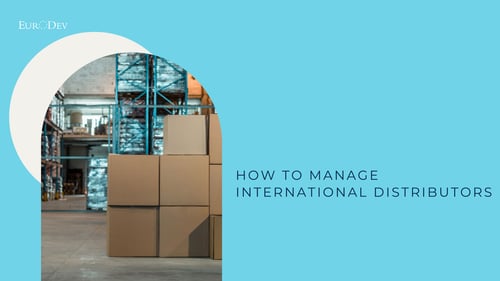Selling Medical Devices in Europe
Now that Europe has new Medical Device Regulations that govern the process of placing medical devices on the European market, it is important to analyze the step-by-step processes. This is a process advised not only on the European market but any time you plan to launch any medical device or product on any market. This article will detail the steps you should consider while entering the European market.
Step 1: Determine if the product is a medical device as per the EUMDR or EU IVDR
The first thing you should always ask is if you are manufacturing a medical device or not. Having this answer might ensure you skip some of the steps listed here or even reduce the amount you might spend on acquiring certain certifications. If the product is not a medical device, it will be subject to other regulations. For instance, is it a food supplement, retail product, and many others?
As per the European Union Medical Device Regulations (EU MDR), a medical device is defined as “any instrument, apparatus, appliance, software, implant, reagent, material or other article intended by the manufacturer to be used, alone or in combination, for human beings for one or more of the following specific medical purposes;”
- Diagnosis, prevention, monitoring, prediction, prognosis, treatment, or alleviation of diseases,
- Diagnosis, monitoring, treatment, alleviation of, or compensation for an injury or disability,
- Investigation, replacement, or modification of the anatomy or of a physiological or pathological process or state,
- Providing information by means of in vitro examination of specimens, derived from the human body, including organs, blood, and tissue donations
Also, those products that do not achieve their principal intended action by pharmacological, immunological, or metabolic means, in or on the human body but may be assisted in their function by such means. These products will also be determined as medical devices. These might include;- Devices that control or support conception
- Products intended for cleaning, disinfection, or sterilization of devices.
To find out more about which products might be included in the definition, read Article 1(4) and Article (2) of the European Union Medical Device Regulations.
It is understandable that some products might not be easy to categorize, for instance, heart rate tracking software. If the software is intended for activities like fitness, in a watch, then it is not categorized as a medical device. If the software is rather used to collect data for diagnosis or monitor disease, then the software is a medical device. It is predicted that the Apple watch will be able to monitor patients’ diabetic levels. Based on the intention of the software and the watch, it will be categorized as a medical device.
If the product is not a medical device as per the EU MDR, then it can also be an In Vitro Diagnostic Medical Device (IVD). IVDs are also medical devices that follow similar regulations as medical devices.
As per the classifications and EU IVDR, an IVD is defined as “any medical device that is a reagent, reagent product, calibrator, control material, kit, instrument, apparatus, piece of equipment, software or systems, whether used alone or combination, to be used in vitro for examination of specimens, including blood and tissue donations, derived from the human body, solely or principally for the purpose of providing information on one or more of the following;”
- Psychological or pathological process or state;
- Congenital physical or mental impairments
- Predispositions and medical conditions or a disease
- Determine safety and compatibility with potential recipients
- Predict treatment responses and reactions
- Define and monitor therapeutic measures.
To understand what constitutes an IVD medical device, it is important to read further in Article (2) IVDR. Based on this step, it is more important to understand the intended purpose of the product to determine if it fits the definitions above or not. For software solution providers, it is important to read more about these solutions under the EUMDR to understand how they might be introduced into the European market.
Step 2: Determine the important legal regulations for the medical devices
If you classify your product as a medical device or IVD product, it is important to then identify the legal regulations you might have to follow. As a manufacturer, placing the products on the European market comes with some requirements you should comply with. It is also important to identify these legal regulations based on the European market in which you want to place the product. Even though medical devices have the EUMDR, different countries also have different regulations that manufacturers might follow to ensure proper market entry.
In most European countries, European law is more important than national law. Hence, it is important to ensure your product is compliant with European law, then consider the national laws as the next step. Some of the most important regulations for medical device manufacturers are
- Regulation 2017/745 on medical devices (MDR)
- Regulation 2017/746 on in vitro diagnostic medical devices (IVDR)
If manufacturers act as economic operators according to the product portfolios, they might face other regulations such as;
- Regulation (EU) 2012/207 – regulation on electronic instructions for use of medical devices
- Regulation (EU) 2016/679 – Regulation on the protection of natural persons with regards to the processing of personal data and on the free movement of such data, and repealing directive 95/46/EC (general data protection regulation)
Some of the EU directives on other medical devices include
- For medical devices that have moving parts - Machinery directives 2006/42/EC
- Products with restrictions such as the use of certain hazardous substances in electrical and electronic equipment– RoHs 2011/65 (EU)
In addition to the European laws, manufacturers must consider the national laws of every country. Check if the country, established some independent regulations for your product if they have implemented the European directives and if they have added these to the European regulations.
In Germany, they have different levels of force towards their law. Manufacturers need to follow the Medizinprodukterecht-Durechfuhrungsgesetz (MPDG). Also, they should follow the Medizinprodukte-Anwendermelde- und Informationsverordnung (MPAIMV) and the Medizinprodukte-Betreiberverordnung (MPBetreibV). As a manufacturer placing medical devices on the German market, it is also important to follow their technical guidelines.
Both the European and national laws are important for manufacturers and hence should treat them equally.
Step 3: Define the regulatory requirements for market entry
If you identify the regulations and laws that apply to your medical device, and the countries you are planning to place your medical products in, your next step is to identify the requirements you might have to follow. This step might be connected to the definition of your product and which class it falls under. Under this process;
- Classify your medical device: Defining the requirements is dependent on the risk class the medical device falls under. Class I products have less strict requirements than Class III products or Class IIb medical devices. To ensure you properly classify medical devices, it is important to follow Annex VIII of MDR (identifies devices from Class I to III) or IVDR(Identifies devices from Class A to D)
- Select the conformity assessment procedure you will follow: Conformity assessment is the procedure for demonstrating that the medical device complies with relevant legal requirements. To ensure proper assessment, it is advisable that you contact a notified body to deal with this process. Proper identification of the risk class will determine which procedure to follow for conformity assessment.
- Review the quality management system (QMS): Having a quality management system is one of the most important requirements in entering the European market or any market. For class A or Class I medical devices, the QMS does not have to be certified by the notified body. Read more about the minimum requirements of the QMS from the EUMDR/ EUIVDR.
- Carry out the necessary technical documentation: Medical device manufacturers must provide technical documentation for their medical devices. This is also a requirement for the conformity assessment and the authorization of the medical equipment.
- Have performance and clinical evaluation: This is usually part of the technical documentation where manufacturers provide all information about the medical device. This is used to reverify the safety and performance of the medical technology when used as intended by the manufacturer. An investigation is required and carried out, and supervision is needed when products are being used on humans.
- Evaluate the usage of the product (usability of the medical device): Furthermore, medical device manufacturers should also ensure the usability of their medical technologies. This evaluation ensures that medical devices can be used safely by the intended users in the intended environment, for the identified purpose and that there would be no unidentified risks from the product. This process is required to ensure the safety of the product of the users. Placing the medical device on the European market requires a summative study that will demonstrate that the device is safe for usage.
- Identify the responsible persons for your product: Manufacturers entering the European market should hire a responsible person with EU residency to ensure that the device is in accordance with the QMS before being placed on the market, ensure that the technical documentation and the conformity are drawn up and kept up to date, ensure post-market surveillance of the product, report any incidents caused by the products and many others. Hiring a responsible person is mandatory and without one, a product cannot be approved for the EUMDR certification. Failure to comply with this can result in a fine of 30,000 in Germany and higher in some other countries.
Step 4: Compliance with the regulatory requirements
After identifying the requirements, manufacturers must show that they are actually following the requirements as per the national law or the EU law. Manufacturers can use standards produced by independent standards organizations. These are usually placed on the products with abbreviations such as;
- DIN - Deutsches Institut für Normung
- EN - European Committee for Standardization
- ETSI – European Telecommunication Standards Institute
- ISO – International Organisation of Standardisation
- IEC – International Electrotechnical Commission
- IEE – Institute of Electrical and Electronic Engineers
- ITU – International Telecommunication Union
These are recognized by public bodies and if manufacturers comply with the standards, there are presumptions of conformity with the requirements of the EU specifications.
It is important you identify the appropriate standard for the medical device. Based on the classifications,
- Identify which requirements or standards your medical device should comply with.
- Based on this, check if there is a standard for the requirement. If there is a harmonized standard, then prioritize them.
You can always start your research on these standards;
- ISO EN 13485 for quality management systems of medical devices
- ISO EN 14971 for the risk management of medical devices
- IEC EN 62366-1 application of the usability of medical devices.
- IEC EN 62304 for the life cycle process of the medical devices software
- IEC EN 60601-1 for the safety and performance characteristics of programmable electrical medical systems
- DIN EN ISO 10993-1 for evaluations and testing within a risk management process for medical devices.
Further, manufacturers should also be aware of some common specifications that are published by the EU commissions. Common specifications for medical devices “means a set of technical and/or clinical requirements, other than a standard, that provides a means of complying with the legal obligations applicable to a device, process or system”
Understanding the regulations and standards that are applicable to your product should lead to the proper implementation of these standards. This might include
- Translating the requirements into your company. Your company should create an SOP and corresponding documents for this.
- Demonstrate appropriate applications.
In this process, also assign the Unique device identification (UDI). This will make it easy for your product to be identified and tracked while on the European market.
Step 5: Authorisation and launching of the medical device on the market
After all the necessary requirements, your medical device is ready to be placed on the European market. Hence take the following steps
- Declare conformity: This involves manufacturers certifying that their products comply with the legal and regulatory requirements. Hence an issuance of the declaration of conformity for the medical device. In most cases, having the certification from the notified body might be needed.
- Register your company as a manufacturer of medical devices: Manufacturers should register themselves as manufacturers on the European database on Medical Device (EUDAMED) platform.
- Register the medical device: Finally, it is important to also ensure that the device is registered with the federal institute of Drugs and Medical Devices (BfArM) or via EUDAMED.
Step 6: Surveillance of the medical device
After the launch of the medical device on the European market, it is required for the manufacturer to ensure its safety and proper usage. Hence, manufacturers should have a process in place that will ensure proper surveillance. This process will entail:
- Post-market surveillance of the medical device
- Vigilance – in case of any accidents, whether minor or serious, should be reported to the relevant authorities.
Manufacturers that are eager to enter the European market must take different regulatory requirements. While this can be a doubting process, you can follow these steps to ensure you have the process under control. Having one product on the market does not guarantee that the next product will also be on the market. You will have to follow these steps for every new product that you want to place on the European market. If you are not sure of your products and still want to enter the European market, feel free to contact your notified body or have a free consultation call with our VP of Healthcare - Stephen Viljoen.
About EuroDev
EuroDev, established in 1996 with offices in The Netherlands and France, has a single, defined purpose to help mid-sized North American companies expand their business in Europe. Since our founding, we have created a proven, successful business development model and partnered with over 300 companies to help them define and meet their European business goals. Services provided include Sales Outsourcing, HR Outsourcing, and Digital Marketing.
Read more about Dos and Don’ts for Medical Device Manufacturers Expanding into Europe
Related articles
-

How to Manage International Distributors
7 February 2024It is essential to invest in an effective distributorship approach. In this blog, you will learn...
Read more -

Key Updates to Dutch Employment Law
25 January 2024Discover key updates in Dutch employment law, from minimum hourly wage to carbon emissions...
Read more -

MEDICA: Expanding Horizons to Europe
7 November 2023Explore the opportunities for expanding your healthcare business into Europe with the Medica trade...
Read more

